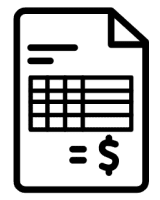Living Paycheck to Paycheck? Project Your Income and Expenses Using a Daily Budget
To ensure you get the best information, you will find ZERO ads, affiliate links, and sponsored posts on this site. Click here to learn more about my mission.
You’ll use this article in the early stages of The 9 Steps to Financial Freedom.
Living paycheck to paycheck is rough.
It’s a constant battle to make sure you have enough in your account to pay your bills while also spending money on discretionary items. So how can you break the vicious cycle?
If you don’t already know, using what I call the “ATM balance inquiry budget method” is not the best way to manage your money. That’s because your current checking account balance does not reflect future bills that need paid or savings goals that need funded before your next income event.
When living paycheck to paycheck you need to start thinking about how you spend/save your money several days (if not weeks) in advance. To do this I recommend creating a daily budget.
Your Daily Budget
You can think of your daily budget as a checkbook register that looks into the future instead of only keeping track of what’s already happened.
Basically, you determine what your account balance is today and then add in the projected (and known) income and expenses you’ll have over the next few weeks.
If you’re a member at The Self-Starter level or higher, a daily budget and instructional videos are included in the financial worksheets package. If you’re not a member, click below to learn about all the great benefits!
You’ll start by adding today’s date in the upper right hand corner. If you’re using the Excel spreadsheet the dates will then populate down the left hand side of the page. If you’re using the PDF you’ll need to add the future dates manually.
Then, add in the current balance of your checking account (minus any pending transactions) at the top of the page. This is the starting point for your daily budget.
What you’ll do next is where the power of the daily budget becomes clear.
First, go through and add in any known income events in the future. For example, if you get paid again on the 20th of the month, go through and find that date and add in the projected transaction. Be sure to add the income in the “Incoming (+)” column.
Look at your list of monthly bills and begin adding them in as “transactions” on the spreadsheet on the day the money needs to come out of the account. For example if your cell phone bill comes out on the 25th, go to that date on the daily budget and add it as an expense. Be sure too add the expense in the “Outgoing (-)” column. You can then see your projected account balance at that time.
After you get your bills entered, go through and add in your anticipated discretionary expenses. If you have a typical day during the week where you stop and get groceries, add that in and estimate what you’re going to spend. Do that with other categories such as dining out, entertainment, etc.
Finally, add in your savings goals and money that needs to be set aside for periodic expenses.
This daily budget allows you to plan out your spending based on what you normally do while also being able to view what your account balance will be projected as before your next round of income.
Therefore, if you add in all of your expenses and see that you don’t have enough money in your account to spend the normal $150 at the grocery store, you need to adjust to make it work. No more overdrafts or floating the expenses on your credit card.
The daily budget is a great first step if you’re living paycheck to paycheck. It will allow you to see where you need to make cuts and where you can potentially save money. If your bills are high, you can begin working on cutting some of them down.
* * * * *



